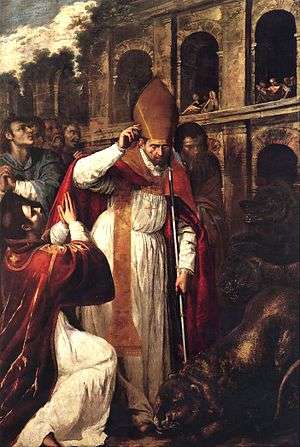Saint Januarius in the Amphitheatre at Pozzuoli
Saint Januarius in the Amphitheatre at Pozzuoli is a 1636-1637 oil on canvas painting by Artemisia Gentileschi. The work shows the moment that the Christian martyr Januarius and his followers are thrown to a group of wild animals in the amphitheatre in Pozzuoli - however, they lick the saint's feet rather than attacking him and Januarius is unharmed.[1]
| The Martyrdom of St Januarius in the Amphitheatre at Pozzuoli | |
|---|---|
 | |
| Year | 1636 |
| Dimensions | 308 cm (121 in) × 200 cm (79 in) |
| Location | Pozzuoli Cathedral |
Along with Saints Proculus and Nicea and Adoration of the Magi, the painting of Januarius was commissioned from her for the choir of Pozzuoli Cathedral. The amphitheatre and figures in the background were painted by one (or more) of Gentileschi's collaborators from Rome. The paintings now hang in their original place in the cathedral, although for a time after fire damage in the 1960s they were curated by the Museo di Capodimonte in nearby Naples. [2]
The fire in 1964 damaged some of the painting, although restorations have partially rectified the damage, and revealed Gentileschi's signature beneath the tail of the lion. [3]
Patronage
On the appointment of a new bishop in 1631, the cathedral of Pozzuoli underwent significant renovations. Gentileschi's painting was one of three she was commissioned to execute for placement above the cathedral's choir stalls. The Adoration of the Magi, and Saints Proculus and Nicea are also still in place in the cathedral. It is likely that existing contacts of Gentileschi, such as the Viceroy of Naples (Manuel de Acevedo y Zuniga), helped secure the commission for her. [4]
Story
Januarius was an early Christian from the third- and fourth-century. He was made Bishop of Naples (where he is still the patron saint) and his protection of Christians raised the ire of the Roman Emperor Diocletian. According to his hagiographers Januarius was arrested, and then survived various attempts to kill him. Gentileschi here portrays one of those attempts, where the saint was thrown into the amphitheatre in Pozzuoli. Diocletian expected him to be attacked by the wild animals, but Gentileschi portrays the moment that the lion and bear are tamed, and with great docility show their obedience to the Bishop.[5] The figure kneeling at the bottom left is Proculus, the deacon of Pozzuoli, who like Januarius would also be martyred. [6]
Critical Reception
Art historians have noted that the style has less of the drama associated with the her earlier paintings, naming it "a balanced and conservative composition." Others have pointed to the need to use a particular tone that would be fitting with the other paintings created for the renovation of the cathedral - this would have obliged Gentileschi to work in a slightly more muted style.[7]
References
- "The Martyrdom of St. Januarius in the Amphitheater at Pozzuoli · Italian Baroque Art". baroque.trinity.duke.edu. Retrieved 2020-05-01.
- "Diocesi di Pozzuoli". www.diocesipozzuoli.org. Retrieved 2020-05-01.
- Treves, Letizia. (2020). Artemisia. [S.l.]: National Gallery(LONDON). pp. 207–9. ISBN 978-1-85709-656-9. OCLC 1117638110.
- Bissell, R. Ward. (1999). Artemisia Gentileschi and the authority of art : critical reading and catalogue raisonné. University Park, Pa.: Pennsylvania State University Press. ISBN 0-271-01787-2. OCLC 38010691.
- Herbert Thurston (1913). . In Herbermann, Charles (ed.). Catholic Encyclopedia. New York: Robert Appleton Company.
- Treves, Letizia. (2020). Artemisia. [S.l.]: National Gallery(LONDON). pp. 207–9. ISBN 978-1-85709-656-9. OCLC 1117638110.
- Christiansen, Keith; Mann, Judith (2001). Orazio and Artemesia Gentileschi. Metropolitan Museum of Art. p. 413.